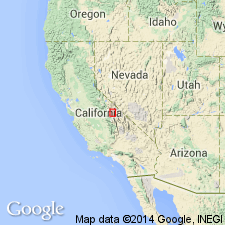
- Usage in publication:
-
- Tungsten Hills quartz monzonite*
- Modifications:
-
- Named
- Dominant lithology:
-
- Quartz monzonite
- AAPG geologic province:
-
- Sierra Nevada province
Summary:
[Named for Tungsten Hills] Type locality: hill [just west of Langley Meadow], 2 mi north 20 deg E of Grouse Mountain in southwestern Tungsten Hills [37 deg 20'N, 118 deg 34'W, Mount Tom 15' quad, Inyo Co, CA]. Crops out discontinuously in northwest-trending belt through central part of mapped area. Typical quartz monzonite; away from margins is medium grained and medium light gray on fresh exposures. Intrudes Wheeler Crest Quartz Monzonite (new), granodiorite of Deep Canyon, Lamarck Granodiorite (new) and Round Valley Peak Granodiorite (new). Intruded by quartz monzonite and alaskite similar to Cathedral Peak Granite. Is Cretaceous age based on lead-alpha ages of 116 and 110 Ma on zircon collected in Morgan Creek and Bishop Creek masses (Larsen and others, 1958).
Source: GNU records (USGS DDS-6; Menlo GNULEX).
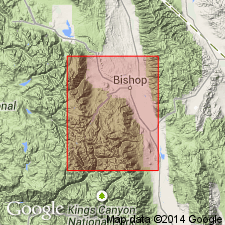
- Usage in publication:
-
- Tungsten Hills quartz monzonite*
- Modifications:
-
- Overview
- AAPG geologic province:
-
- Sierra Nevada province
Summary:
Underlies 120 sq mi within mapped area in Mount Tom, Bishop Mount Goddard and Big Pine 15' quads and continues westerly into Mount Abbot and Blackcap Mountain 15' quads, CA. Includes following named masses: Morgan Creek, Tungsten Hills, Basin Mountain, Bishop Creek, and Shannon Canyon. Typical rocks consists of roughly equal amounts of quartz, plagioclase, and perthite; biotite always present; hornfels absent in most specimens. Recognition of near-granodiorite composition in western part of Basin Mountain suggests these rocks may belong to different intrusive. Albitized facies of unit is separately mapped. Age is Cretaceous.
Source: GNU records (USGS DDS-6; Menlo GNULEX).
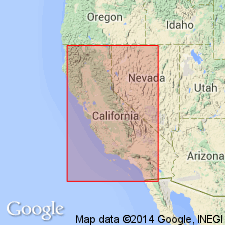
- Usage in publication:
-
- Tungsten Hills Quartz Monzonite*
- Modifications:
-
- Age modified
- AAPG geologic province:
-
- Sierra Nevada province
Summary:
Included in Lee Vining intrusive epoch, event considered to be Triassic.
Source: GNU records (USGS DDS-6; Menlo GNULEX).
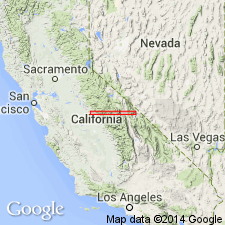
- Usage in publication:
-
- Tungsten Hills Quartz Monzonite*
- Modifications:
-
- Age modified
- AAPG geologic province:
-
- Sierra Nevada province
Summary:
Tungsten Hills Quartz Monzonite (Bateman, 1965a) is shown to be Triassic rather than Cretaceous based on radiometric age dating done since earlier publication.
Source: GNU records (USGS DDS-6; Menlo GNULEX).
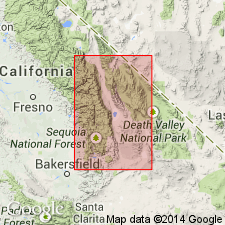
- Usage in publication:
-
- Tungsten Hills Quartz Monzonite*
- Modifications:
-
- Geochronologic dating
- AAPG geologic province:
-
- Sierra Nevada province
Summary:
U-Pb age on zircon of Tungsten Hills Quartz Monzonite yielded 198 Ma.
Source: GNU records (USGS DDS-6; Menlo GNULEX).
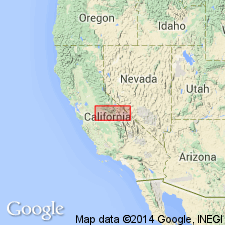
- Usage in publication:
-
- Tungsten Hills Quartz Monzonite*
- Modifications:
-
- Geochronologic dating
- AAPG geologic province:
-
- Sierra Nevada province
Summary:
Included in Scheelite granitoid sequence. Sample 52 (location shown on map) of Tungsten Hills Quartz Monzonite has Pb-U-Th isotopic ages of 204.4 to 201.9 Ma.
Source: GNU records (USGS DDS-6; Menlo GNULEX).
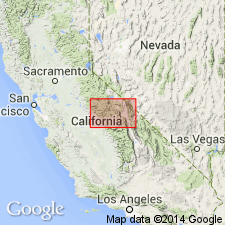
- Usage in publication:
-
- Tungsten Hills Granite*
- Modifications:
-
- Redescribed
- Revised
- Age modified
- Dominant lithology:
-
- Granite
- AAPG geologic province:
-
- Sierra Nevada province
Summary:
Included as youngest unit of Scheelite Intrusive Suite (new). Tungsten Hills Quartz Monzonite (Bateman, 1965) originally showed it to be more extensive. Rocks here excluded are those west of Pine Creek septum and south continuation around and south of Mount Humphreys which have been reassigned to Lake Edison Granodiorite (new). Name changed to Tungsten Hills Granite to reflect current IUGS classification (Streckeisen, 1973). Typical rock is medium grained seriate or weakly megacrystic, light colored. Intrudes Wheeler Crest Granodiorite; is intruded by leucogranite of Rawson Creek, Granodiorite of Coyote Flat and small masses of fine-grained granite and aplite (all of Cretaceous age). Younger K-Ar ages obviously have been reset. U-Pb ages of 202 and 197 Ma (Stern and others, 1981) [= Late Jurassic].
Source: GNU records (USGS DDS-6; Menlo GNULEX).
For more information, please contact Nancy Stamm, Geologic Names Committee Secretary.
Asterisk (*) indicates published by U.S. Geological Survey authors.
"No current usage" (†) implies that a name has been abandoned or has fallen into disuse. Former usage and, if known, replacement name given in parentheses ( ).
Slash (/) indicates name conflicts with nomenclatural guidelines (CSN, 1933; ACSN, 1961, 1970; NACSN, 1983, 2005, 2021). May be explained within brackets ([ ]).

